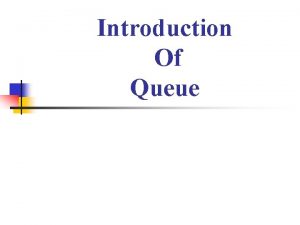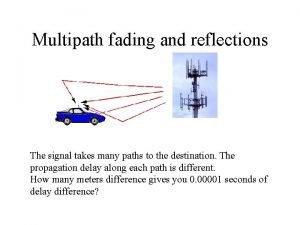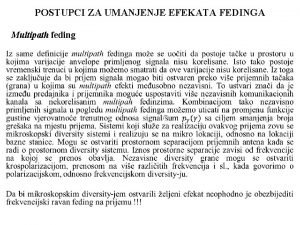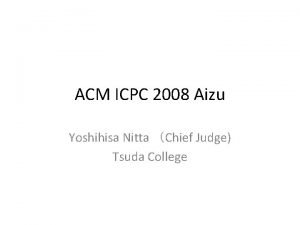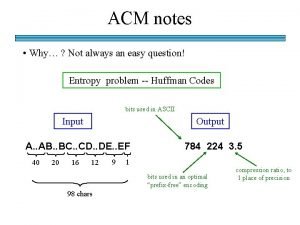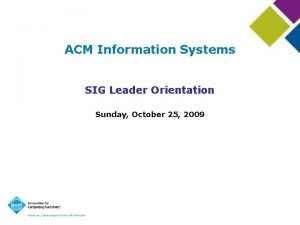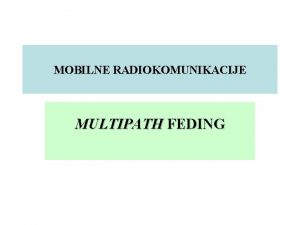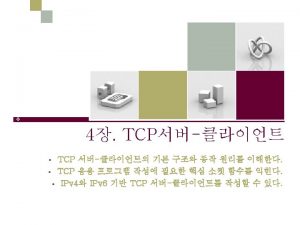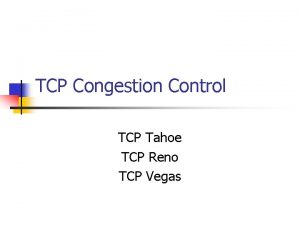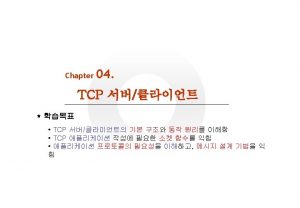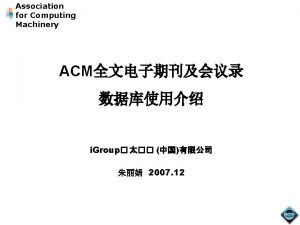Multipath TCP ACM Queue Volume 12 Issue 2












- Slides: 12

Multipath TCP ACM Queue, Volume 12 Issue 2, pp. 1 -12, February 2014 Christoph Paasch and Olivier Bonaventure University College London 1

Outline • Motivation • MPTCP – Design Goals • MPTCP – Establish Connection • MPTCP – Add Subflows • MPTCP – Transmit Data • Congestion Control • Devil of Middleboxes • Conclusion 2

Motivation • In addition to usual load balancing, such as load balancing between two interfaces and two gateways, my system is going to make one packet sent from different paths. • In order to realize the target, there is a protocol made this target come true. 3

MPTCP - Design Goals • Using multiple network paths for a single connection. • Must be able to use the available network paths at least as well as regular TCP • Regular TCP is usable as usual for existing applications. • Enabling MPTCP cannot interfere regular TCP work. 4

MPTCP – Establish Connection • An MPTCP connection is established by using the three-way handshake with TCP options to negotiate its usage. • MP_CAPABLE : supports MPTCP • Key : for security purposes 5

MPTCP – Add Subflows • Corresponding MPTCP connection must be uniquely identified on each end host. • Use regular TCP option for joining the corresponding MPTCP 6

MPTCP – Add Subflows (cont. ) • MP_JOIN token : replacing MP_CAPABLE • rand (key) : for security purposes • HMAC (hash-based message authentication code) : for authentication 7

MPTCP – Transmit Data • Data transmitted over one subflow can be retransmitted on another to recover from losses. • From congestion-control viewpoint, if the MPTCP-enabled client uses two subflows, then it will obtain two-thirds of the shared bottleneck. 9

Congestion Control • Adjust the TCP congestion window on each subflow • The aggregation of congestion windows could not grow faster than a single TCP connection 10

Devil of Middleboxes • The middleboxes, such as firewalls , NATs, and load balancers, would modify the TCP header or the payload of passing TCP segments. • Absolute data sequence number would cause several packets with the same sequence number. This makes the reorder process failed. • Mapping data sequence number is the solution for reconstruct the data stream. It defines the beginning and the end of the datasequence number. • The beginning : with respect to the subflow sequence number • The end : indicating the length of the mapping 11

Conclusion • MPTCP is a major extension to TCP. MPTCP makes the transmission more efficient. It considers all the situation that might happen on IP and TCP. MPTCP is more integral than regular TCP. 12

Reference • Christoph Paasch and Olivier Bonaventure, “Multipath TCP”, ACM Queue, Volume 12 Issue 2, pp. 1 -12, February 2014 • M. Handley, O. Bonaventure, C. Raiciu, & A. Ford, “TCP extensions for multipath operation with multiple addresses”, IETF RFC 6897, March 2014. 13
